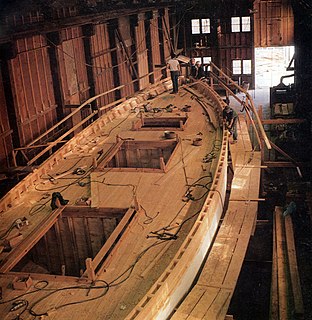Top Hat 25 is a series of English designed yachts made in Australia from 1964 to 1986. It came in four different 'marks' (models) named Mk 0 - III. After the Mk III, another model, the Top Hat 27, was launched in 1986.

Boat building is the design and construction of boats and their systems. This includes at a minimum a hull, with propulsion, mechanical, navigation, safety and other systems as a craft requires.

The Wayfarer is a wooden or fibreglass hulled fractional Bermuda rigged sailing dinghy of great versatility; used for short 'day boat' trips, longer cruises and for racing. Over 11,000 have been produced as of 2016.

The Westsail 32 was a production fiberglass sailboat built between the years of 1971 and 1980. Approximately 830 were built, about half of them in kit form. The "W32", as they are often referred to, was very heavily built and has taken many people on trouble-free voyages and several circumnavigations. Often thought of as a slow boat, the long waterline and incredible load carrying capabilities of this vessel make it an excellent cruising boat. The Westsail was directly derived from the earlier Kendall 32, of which only a few were made.
118 WallyPower, christened Galeocerdo, is a 118-foot (36 m) luxury motor yacht with a maximum speed of 60 knots produced by Wally Yachts. The yacht is narrow and angular in design with black glass housing, driven by three Vericor TF50 gas turbines generating 5,600 horsepower (4,200 kW), each driving a Rolls-Royce Kamewa water jet, two steerable outboard and a non-steering booster on the centerline. The steerable water jets also have a diesel engine input for a 370 hp (280 kW) Cummins diesel, thus making the ship a Combined Diesel or Gas Turbine (CODOG) configured vessel. The total power output is 16,800 horsepower (12,500 kW). One 118 WallyPower has been constructed and it is owned by the Kondakji family, with a cost of £14M.

The Adventuress sailing dinghy class was designed by Ian Proctor and built by Anglo Marine of Essex. It is no longer in production.

The Contessa 32 is a 9.75 metre (32 ft) fibreglass monohull sailing yacht, designed in 1970 by David Sadler in collaboration with yachtbuilder Jeremy Rogers, as a larger alternative to the Contessa 26. With over 750 hulls built, the yacht has become the most successful one-design cruiser-racer of all time. The yachts have a masthead sloop rig, with a fin keel and a skeg-mounted rudder, a cutting edge concept for the period which now represents a cross between newer and older designs.
Fairey Marine Ltd, latterly known as FBM Marine, was a boat building company based on the River Hamble, Southampton, England. The company was created in the late 1940s by Sir Charles Richard Fairey and Fairey Aviation's managing director, Mr. Chichester-Smith. Both were avid sailing enthusiasts along with Chichester-Smith's good friend and former Olympic yachtsman, Charles Currey.
The 2000(formerly the Laser 2000) is a performance sailing dinghy designed by Phil Morrison and currently sold by RS Sailing. It combines a traditional GRP hull and foam sandwich deck moulding with a modern asymmetric rig including a furling jib, reefing mainsail and single line gennaker hoist system.

The Hornet dinghy is a 16-foot-high performance dinghy designed by Jack Holt in 1952.
The Seaway 25 was designed by Doug Peterson of USA fame for Tom Stevenson in 1978 after Tom won the World half Ton championship in one of Doug's designs. The yacht was designed to sail well on the short sharp chop of Port Phillip Bay Melbourne Australia. Intended to rate as a quarter ton Trailer yacht under IOR and Junior Offshore Group racing both for Harbour and Inshore Yacht racing.
The Corribee is a model of sailing yacht with good sea keeping ability. It was in a Corribee that Ellen MacArthur sailed around Britain.

The C&C 37/40 is a Canadian 12.05 metres (39.5 ft) LOA fibreglass monohull sailing yacht, designed in 1988 by Robert W. Ball of Cuthbertson & Cassian as a replacement for the earlier C&C 37 dating from 1981. The C&C 37/40 is a recreational keelboat of moderate displacement, intended as a cruiser/racer or oceangoing racer. The yachts have a masthead sloop rig, with a fin keel and an internally-mounted spade-type rudder. Over 110 of the 37/40 type were built before the Canadian plant closed in 1994. The design is no longer produced.

The Bluejacket 23 is a 23-foot (7.0 m) Canadian fibreglass monohull sailboat designed by Cuthbertson & Cassian as a day sailer and club racer and first built in 1967.

The C&C 57 is a Canadian sailboat. The design was built by C&C Yachts in Canada, but it is now out of production.
The Watkins 27P, also known as the W27P, is an American sailboat that was designed by naval architect Walter Scott and first built in 1981.
The Watkins 36, also known as the W36 and W36AC, is an American sailboat that was designed by William H. Tripp Jr and the Watkins brothers, first built in 1981.
The Watkins 36, also known as the W36C, is an American sailboat that was designed by William H. Tripp Jr and the Watkins brothers. It was first built in 1981.
The Watkins 29, also known as the W29, is an American sailboat that was designed by Walter Scott in conjunction with the Watkins brothers and first built in 1984.
The Watkins 25, also known as the W25 and marketed as the Seawolf 25 from 1986, is an American sailboat that was first built in 1983.









